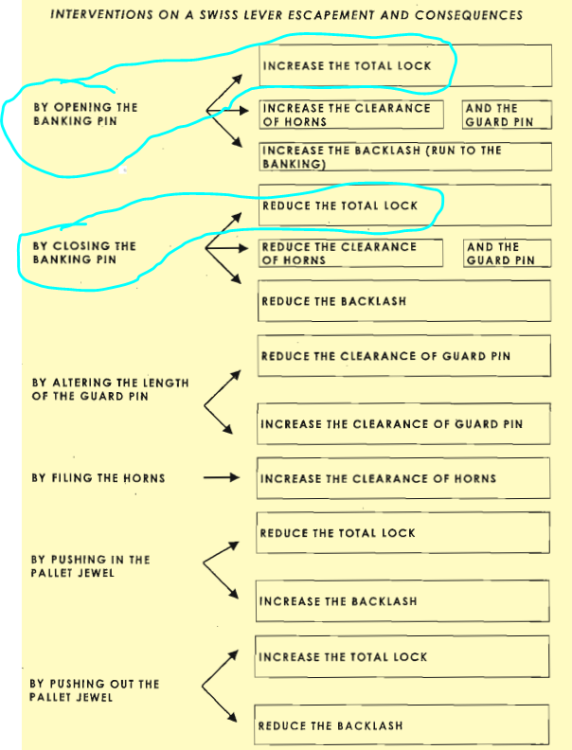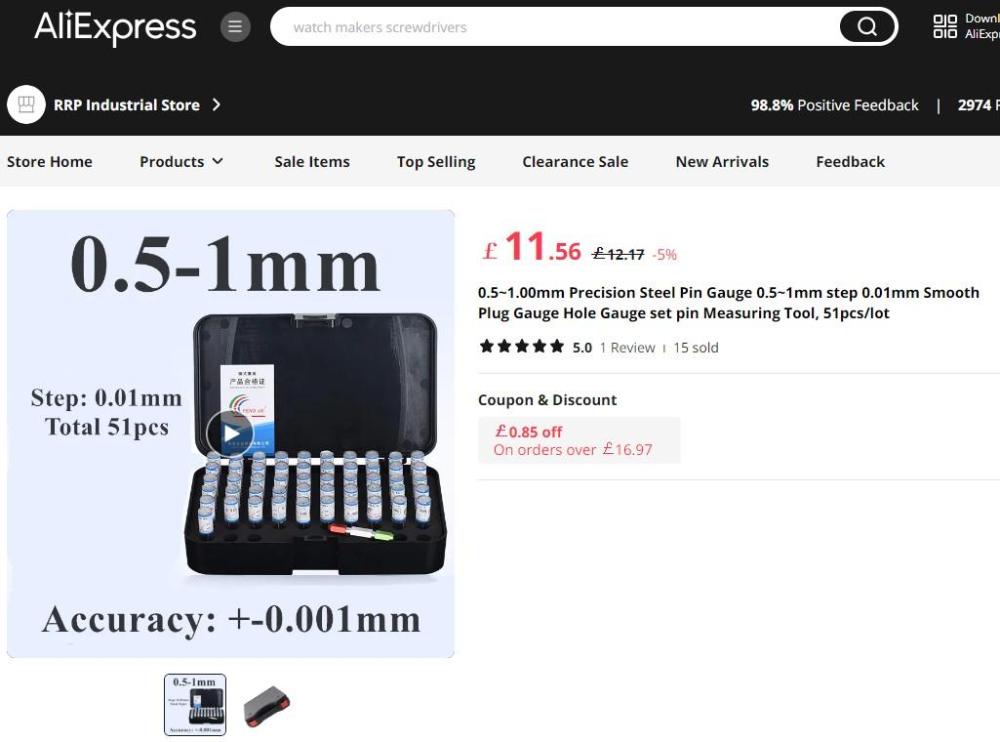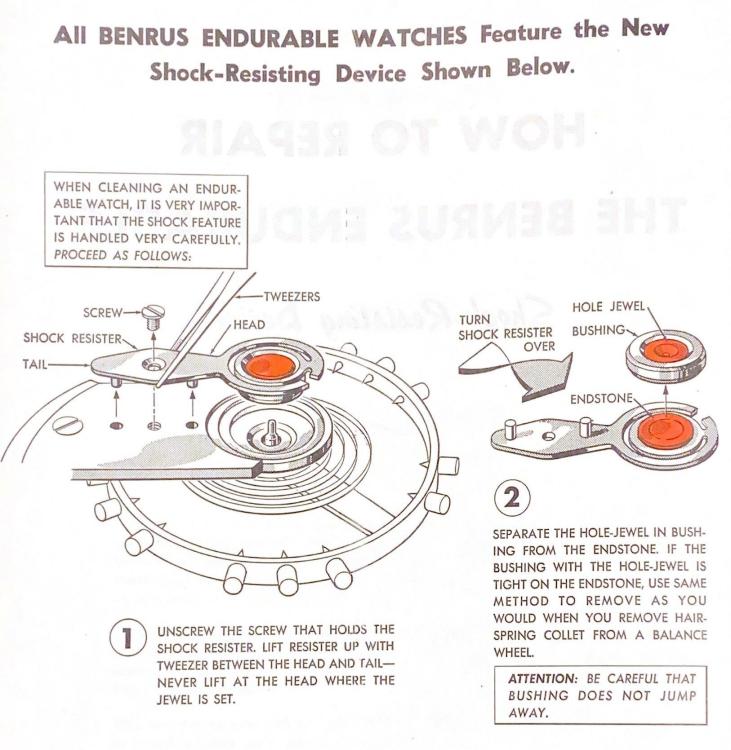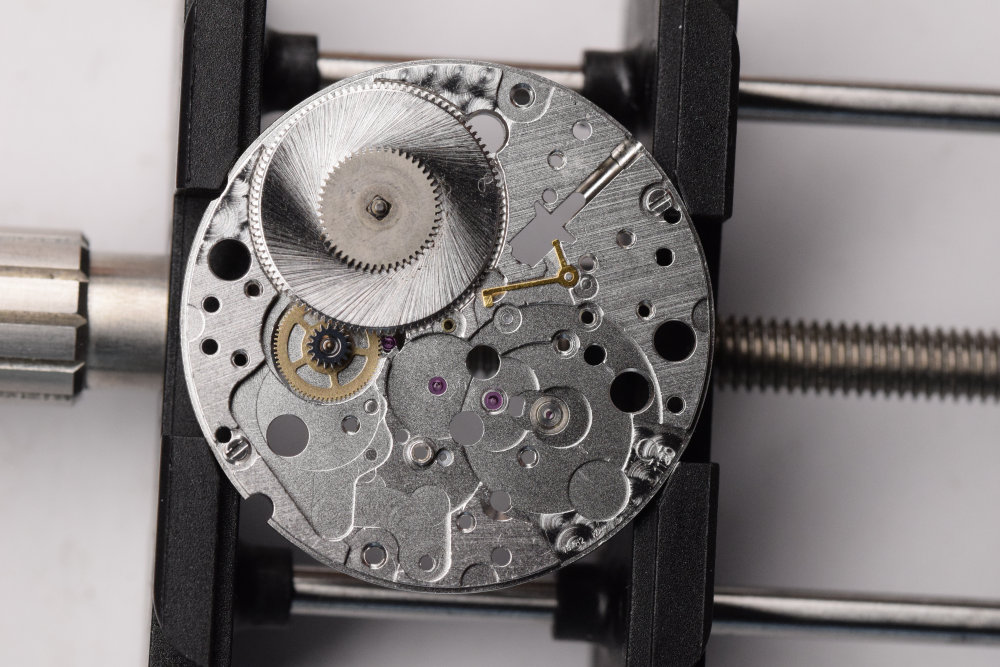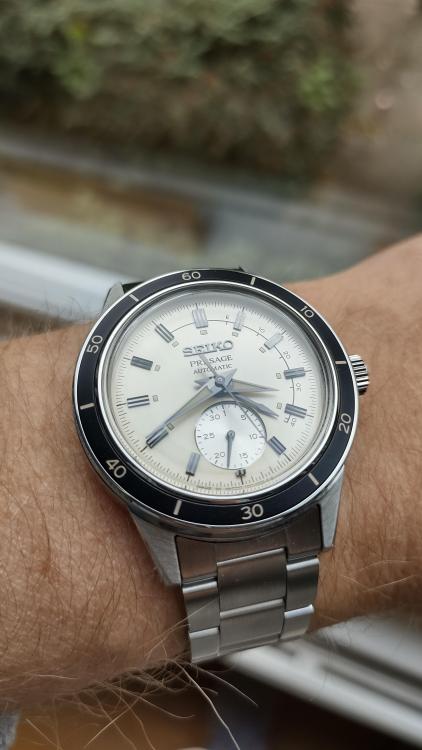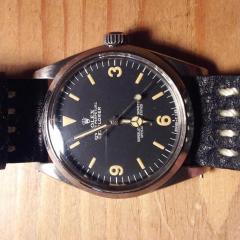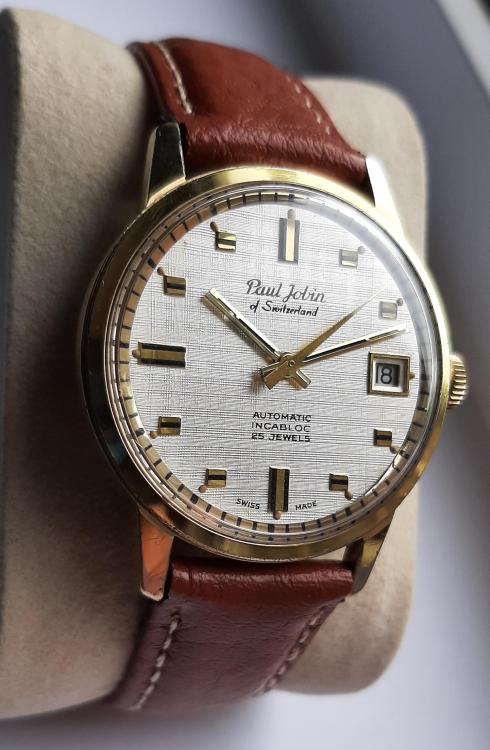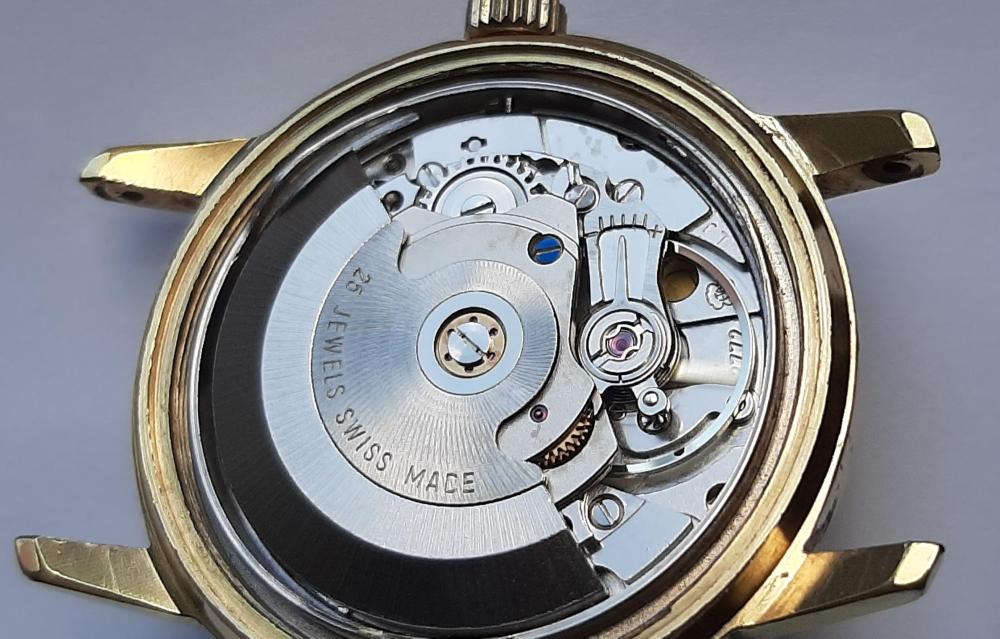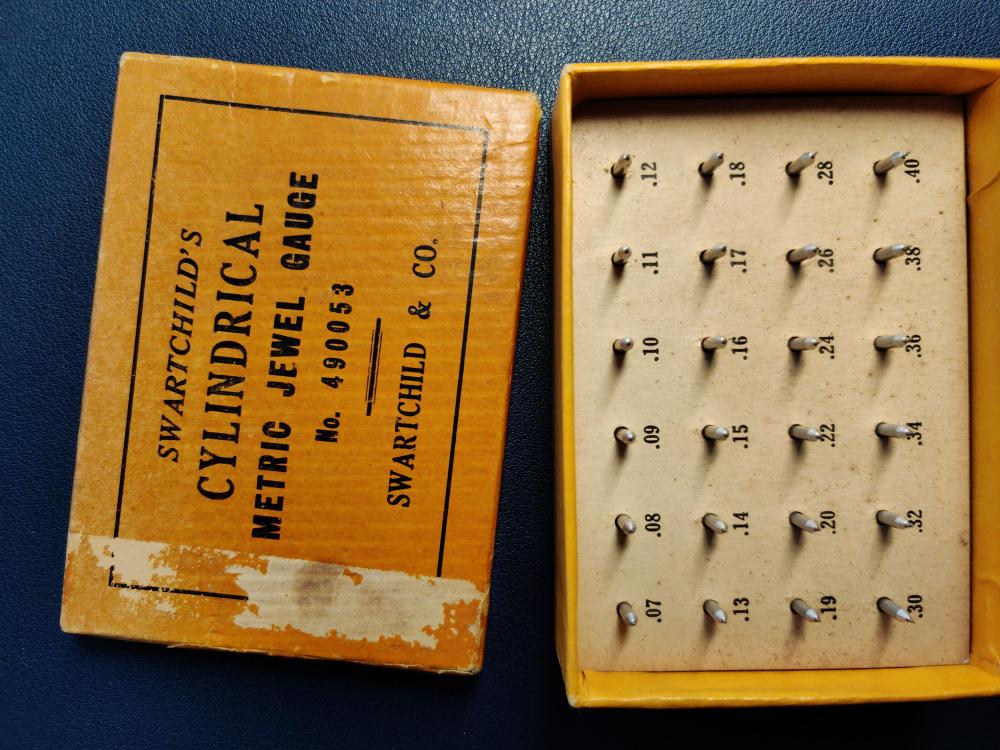Leaderboard
Popular Content
Showing content with the highest reputation on 10/19/23 in Posts
-
4 points
-
3 points
-
That's not the case. The wider the banking pins the deeper the lock of the pallet stones (jewels) with the escape wheel and vice versa3 points
-
I bought these pin gauges a few months ago, as well as the 1 mm to 2 mm set. They are bang-on when it comes to their thickness. Really helps when re-bushing, so you don't have to remove the bridge or mainplate to measure the bored-out hole. I've got a set of Bergeon pin gauges measuring 0.07 to 0.5 mm, which cost a small fortune but couldn't do without them for smaller work and measuring the inside diameter of jewel holes. The same seller does pin gauges from 0.1 to 1 mm https://www.aliexpress.com/item/1005005362640246.html?spm=a2g0o.order_list.order_list_main.31.21ef1802cKI5O73 points
-
2 points
-
He was such a nice guy and knew his stuff, no pressure sales. I could try on as many watches as I wanted. At one point we had 5 watches out comparing and contrasting. Absolutely brilliant experience to treasure. Definitely going back to his shop next October.2 points
-
Hi. The problem watching videos is you only get the best bits not the cock ups or the mistakes these are all edited out, best use them as guide lines not as gospel. All watches are the same but different ways of achieving the the same result. There subtle changes between movements of the same family, So as Waggy points out there will be failures but in the process lessons learned. It’s a fascinating and frustrating hobby.2 points
-
Tom, the configuration found in your watch is listed in the product literature as the "Benrus Special" shock absorber, a very early design. Notice that there is a single screw on the end of a thin extended arm holding the jewel in place, so in effect that whole part is the spring. Benrus refined that type of shock mounting in the next generation, which was called the "Endurable" shock mounting. Similar design, but they added two posts on opposite sides of the screw so that sideways motion was eliminated. (I'm sure that was needed, because when I look over old movements with the "Special" design the cap jewel is often misaligned to the side...) The Endurable also had cutouts around the jewel to add more flexibility, and that appears to be the product that actually arose from the patent Richard provided above, although the posts have been rotated 90 degrees from the patent diagram. See the Benrus technical catalog listing of their shock systems and part of the Endurable service document below.2 points
-
Compared to images found with a Google search I would suggest the following It is probably a genuine seiko movement but 1. In the top picture where the righthand red circle is the fixing screw is missing its head 2. It looks like the auto wind bridge is missing. 3. Going by the colours I would suggest it's what's known as a Mumbai Special. That is if unfamiliar with the term, a watch made up in India from a random selection of parts and the dial is probably a reprint all put in a random case. Depending on the price I might make a good practice watch or a donor for parts. So a genuine parts watch with a reprinted dial is my guess1 point
-
In modern automatic mechanisms and what I teach to my students, HP 1300 would be used on the pivots/arbors of reverser wheels, pawl winding wheels, and driving wheels in the auto mechanism. I teach how to service older movements such as Felsa 690 Bidydnators (which have what is known as 'pawl winding wheels') and ETA 1256 which want the servicer to use thinner lubricants. Lubricants have come a long way since then (1940/50's). The reason for using certain lubricants in certain areas in the gear train is a pretty hard and fast rule. Low speed/high torque, such as barrel arbors use a thicker grease, such as HP 1300, or even D5 as the viscosity is high, as you go down the train the viscosity gets lower, so if you have those lubricants, what would be used is HP 1000 on the centre wheel (second wheel)l, HP 500 on the third wheel (dependent on the size of the movement), 9010 on the fourth wheel (maybe 9020), escape wheel and caps use 9010. So high-speed/low-torque wheels use a lower viscosity. Hopefully one can see the reasoning behind this. With the auto mechanism, the lubricant isn't going to affect amplitude as it would in the gear train, so longevity is what one is trying to achieve, so a thicker grease is used. All modern movements use this method for good reason. HP 1300 has a viscosity of 1300 centistokes and 9504 and 9501 which is great for high friction work such as keyless work and chronograph mechanisms has a viscosity of 305 centistokes. To have that longevity a thicker grease is usually used, for the reason I have given. I know I have probably opened a can of worms here, but I do give reasons for which lubricant is used where, and why. If you ask 10 watchmakers which lubricants they use there will be at least fifteen answers! https://www.moebius-lubricants.ch/en/products/greases https://www.moebius-lubricants.ch/en/products/oils1 point
-
I think he was trying to backtrack on what he already said. I waited until someone else reinforced the answer. Nice one @JohnR725! Drop isn't the same as lock, no matter how you word it @nevenbekriev1 point
-
Anyone who works with Timex and pin pallet movements deserves everyone's respect in my experience and opinion, as breathing life into these watches takes some doing. It's like the difference between working on a Model T Ford and a Ford Astra!1 point
-
You have highlighted why working on clone movements is a fruitless effort if something doesn't work quite right. If it is an ETA driving wheel and cannon pinion, you would replace it as standard practice, rather than bodge it as suggested to you earlier. I'm confused about how removing it and then replacing it would have any effect on its tightness as no explanation was given. If anything it would make it looser, but hey! That's not to say it can't be done, but removing the cannon pinion from the driving wheel may very well distort the wheel badly. If it isn't distorted then the two 'arms' could be brought together, but judging how much and how tight is a bit of a guess until it goes together again. Again, replacing the cannon pinion could likely distort the wheel. Good luck with it! I'm confused by that as well1 point
-
I worked on a lot of Timex movements early on, they are not that difficult if you follow the Timex service instructions. Generally, you do not take them completely apart as you would other watches (although you can), but there are some things to be aware of. For instance, the dial tabs can be a problem, if they are flexed too much they can break. None of the Timex movements I have worked on were riveted, I don't know why people keep saying this. You can find service info in the document stash that I maintain, here is the link - https://drive.google.com/drive/folders/0B-IKHN7WFKiwY3JMMDJnMld2SE0?resourcekey=0-7myGNNAUiShb5ihA-o6PnA&usp=share_link Cheers!1 point
-
As I say to my students, 'Just because it's on YouTube doesn't make it the truth!' @semmyroundelIf you're in or near London I teach watchmaking courses for complete beginners to the seasoned horologist. You might be interested to learn the correct way, rather than the steep learning curve of YouTube videos. Check out my website: https://www.jonthewatch.co.uk/ Instagram: https://www.instagram.com/jonthewatch/1 point
-
1 point
-
Seiko Presage 1960s style with small seconds style date indicator and power reserve, champagne cream dial. Just bought yesterday in Hong Kong for £365 brand new with Seiko Worldwide warranty. The price was just too good (£570 in UK) Watch shop was in Po Lam area of Hong Kong in the shopping mall and they had 30% off ticket price of all Seiko and 25% off Citizen. Some bargains to be had there. They had the Citizen 'Tsuyosa' for £190 and the new Pantone colours for £250.1 point
-
The watch is running at +5 sec a day,beat error is 0.6ms don't think it's overbanking as it runs flawless on the bench in the case,I am wondering if the mainspring is not pushing in enough power through the train when it's on my wrist and I'm moving about? Is this a possibility any suggestions will be most appreciated regards Steve Well first of all THANKYOU ALL for all your help i have tried everything, i stripped down the movement, polished the fourth wheel pivot,cleaned the mainspring, checked every wheel and pivot,cleaned everything and put it back together,ran great for about one hour then stopped. Took the movement out,blew the balance,hardly moved,looked over the movement from the side and BINGO,the balance was just catching on the centre wheel,couldn't see it from the top,just lifted it ever so slightly using a thin piece of plywood,it's now running perfect into it second day,amplitude is 310,running at plus 4 seconds a day,beat error 0.4ms,pretty damm happy with that, Thanks again for all your help,it's great learning so many ways to fix a watch regards Steve1 point
-
Scott, I really appreciate your honesty and absolutely not taken the wrong way. When I started out in boiler repair some 30 years ago, I made some mistakes and had to tell the customer "I'm just getting something from the van" whereupon I'd leg it out and on my brick mobile, I'd phone the boss who was by then a veteran boiler engineer and ask him what the hell to do. So I get it, there's a learning curve with everything, and after taking the movement out of the case, immediately I noticed that this had a cage to hold the movement inside, not seen that in any video online, and the auto winding train didn't seem to come off like other (ETA) movements I'd seen. So I knew I might have thrown myself in the deep end, so appreciate your kind offer of waiting until I have a few under my belt. To that end, I have some non-running Timex bought off Ebay, that were cheap enough to ruin, plus an old Newmark that belonged to a distant family member1 point
-
Looks like a 6001, see link here I just acquired a 6001 in a batch of watches - are you looking to refurbish it? As this has sentimental value I would advise you leave it on a shelf for now until you get a few wins under your belt with watches you aren't worried about junking. As your grandfather gifted this to you and your chances of junking it is high (given you are just starting out on your journey) I would wait until you are confident there will be no tears. Please accept this advice as well intended, I'm just trying to save you some heartache not wag my finger at you and insinuate that you can't handle it. Nobody is born a watchmaker and it took me over 20 wathces (and tears) until I finally started winning more than I was loosing - and I still have the occasional train wreck! If you want, and you are ready, I can wait and work on my 6001 at the same time you are working on yours - two heads are better than one!1 point
-
Hello an£ welcome to the forum. There is a site. “TheWatchSite”. Which deals exclusively with Seiko , Citizen watches. Might be worth a try. The one you have, the number by the balance is indeed the calibre.1 point
-
First place to go for caliber identification is; Citizen 6001 ranfft Where Dr ranfft shows you a picture of 6001. Good luck Pal.1 point
-
1 point
-
Sometimes shining the light at different angles can help. I remember you saying you thought it came from Ireland I forgot to say there was nothing in the case design or the dial painting to indicate that it did. There is a vol two book which Brian Loomes is the author1 point
-
That was an interesting study. I never thought I'd see the word "gonadol" in print, but there it is: "Robinson (1968) estimated the average gonadol dose-equivalent rate was 3 339 mrem/y (0.03 mSv/y) for each of the 10 million people in the USA who wore such watches . . . ." I guess the upshot of the study is to take precautions not only with the radium but also with the radon gas.1 point
-
If you pull the crown out to the setting position does a little tab pop out of the side of the movement? If so, and especially if it has a little dimple in it, try pushing down on that to release the stem.1 point
-
Just finished working on this 70s Paul Jobin 25 Jewel ETA 2772. As expected from ETA, easy to set up and great performance on the timegrapher. I'm wearing it today for a test. BUT . . . I didn't realise until yesterday, when I was casing it up, that this movement joins those ETA movements with the infamous design flaw. i.e. if you don't have the crown in the hand setting position when removing the stem, the clutch is not constrained, and the yoke can come out of the slot. . . . so off with the hands, dial, date mechanism to reset the yoke and clutch I've added a note in big red letters in my copy of the service sheet.1 point
-
I think Sherlock Holmes was working his pocket watch movement when he coined the adage "Once you eliminate the impossible, whatever remains, no matter how improbable, must be the truth."1 point
-
Thanks Richard, I lubricated the gasket and it I think I have it together. I needed to lay the movement into the bezel first and then place the case in the press. Now I need to locate a crystral to fit. I can't find it as a part online so I will need to measure and purchase one to fit. I have measured the bezel without the crystal gasket at 26mm but I'm not sure if I should measure with or without the gasket in place, can you help?1 point
-
Pick up this Stuhrling 90050 as a non runner found quicky the Mainspring had come un-hook from the arbor or the arbor came un-hook from the Mainspring however you like to say it Also the crystal was cracked. I fix the Mainspring problem just to see if it would run and it did but on my Timegrapher it needed some TLC so after the service and a new crystal and also a new Silicone watch band I had not too bad of looking watch. Just to note the movement used it this from my research appears to be one of the 2650 Chinese standard automatic movements (PTS): 2650SSZ. It’s 20 jewels and non-hacking. Stuhrling blued the screws and added some minor engraving.1 point
-
1 point
-
Well, I expected simple answer like 'yes, it does' or 'no, it doesn't'. In fact, moving the banking pins doesn't affect in any way locking. Locking only depends on pallet stones position in the slots0 points



